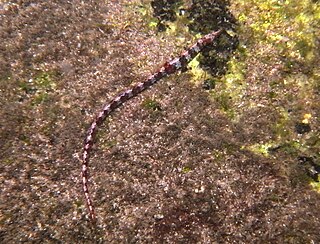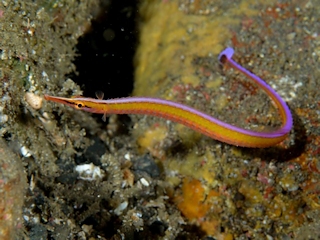The deep-bodied pipefish is a species of marine fish belonging to the family Syngnathidae. They can be found in shallow estuaries and algal beds along the coast of South America from Ecuador to Argentina. Predators of this species include mackerel and the La Plata dolphin. Reproduction occurs through ovoviviparity: the eggs are carried in a pouch under the tail of the male until they hatch.
Phoxocampus is a genus of pipefishes native to the Indian and Pacific Oceans, with these currently recognized species:
Corythoichthys paxtoni, commonly known as Paxton's pipefish, is a species of marine fish of the family Syngnathidae. It is endemic to the Coral Sea, being found in the Great Barrier Reef, the Chesterfield Islands, and New Caledonia. It inhabits coral reefs and rubble lagoons to depths of 18 metres (59 ft), where it can grow to lengths of 13 centimetres (5.1 in). This species mates monogamously and is ovoviviparous, with males carrying eggs until giving birth to live young.
Cosmocampus investigatoris is a species of marine fish of the family Syngnathidae. It is found in the Indo-West Pacific, from the Persian Gulf to the Gulf of Thailand. It lives over sand, mud, and coral bottoms to depths of 15m, where it can grow to lengths of 9 cm. This species is ovoviviparous, with males carrying eggs in a brood pouch until giving birth to live young.
Festucalex prolixus is a species of marine fish of the family Syngnathidae. It is found in the Western Central Pacific, from the Sulu-Celebes Sea and around west Papua New Guinea, Indonesia, including Cenderawasih Bay. Known specimens come from trawls of 0–167 metres (0–548 ft), so it is thought to inhabit waters deeper than 40 metres (130 ft). Very little is known about this species, but it is expected to be ovoviviparous and to feed on small crustaceans.
Lissocampus bannwarthi is a species of marine pipefish belonging to the family Syngnathidae.
Microphis insularis, also known as the Andaman pipefish, is a species of freshwater pipefish belonging to the family Sygnathidae. This species is found only in rivers and streams located in the Andaman Islands, India. They can reach 16 cm (6.3 in) in length and reproduce through ovoviviparity, in which males carry eggs and give live birth. The Andaman pipefish is considered threatened likely due to the effects of habitat degradation, invasive species, and the alteration of flow of its freshwater habitats.
Ichthyocampus carce, also known as the freshwater pipefish or Indian freshwater pipefish is a species of marine fish belonging to the family Syngnathidae. It can be found mainly in freshwater streams, rivers, and estuaries located in the Indian Ocean and West Pacific, from Indonesia to the western coast of India. It can live in both inland and coastal waters. This species can grow to a length of 15cm and feeds primarily on small invertebrates and zooplankton. Reproduction occurs through ovoviviparity, in which the males carry eggs in a brood pouch before giving live birth. Males of this species can brood roughly 280 offspring at a time.
Hypselognathus rostratus, also known as the knife-snouted pipefish is a species of marine fish belonging to the family Syngnathidae. This species can be found in very shallow coastal waters of southeastern Australia. Their habitat consists of sandy substrates, seagrass beds, and estuaries. Reproduction occurs through ovoviviparity in which the males brood eggs before giving live birth.
Lissocampus fatiloquus, also known as prophet's pipefish is a species of marine fish belonging to the family Syngnathidae. The species has been noted in a variety of habitats including sargassum, seagrass beds and sandy substrates along the coast of Western Australia from Shark Bay to Rottnest Island. Their diet is thought to consist of small crustaceans such as copepods. Reproduction occurs through ovoviviparity in which the males brood eggs before giving live birth.
Lissocampus filum, also known as the shortsnout pipefish, is a species of marine fish belonging to the family Syngnathidae. This species can be found in tidepools, algae beds, and estuaries in the coastal region surrounding New Zealand and the Chatham Islands. Its diet is thought to consist of small crustaceans such as copepods. The yellow-eyed penguin has been recorded as a predator of Lissocampus filum. Reproduction occurs through ovoviviparity in which the males brood eggs before giving live birth.

Lissocampus runa, also known as the javelin pipefish is a species of marine fish belonging to the family Syngnathidae. This species can be found in algae beds, rocky reefs, tidepools, and estuaries along the coast of southern Australia from Broken Head Nature Reserve in New South Wales to Rottnest Island, Western Australia. Their diet is thought to consist of small crustaceans such as copepods .Reproduction occurs through ovoviviparity in which the males brood eggs before giving live birth.
Maroubra perserrata, also known as the sawtooth pipefish is a species of marine fish belonging to the family Syngnathidae. This species can be found at depths up to 20 meters along the coast of Australia from southern Queensland to southern Western Australia. While they can live in many different habitats, they are often found inhabiting openings in reefs and rocks that contain algae and invertebrates, which they likely rely on for camouflage. Reproduction occurs through ovoviviparity in which the males brood eggs for roughly 22 days before giving live birth. Maroubra perserrata is considered more mobile than many pipefish species due to its prehensile tail and reduced caudal fin.
Penetopteryx taeniocephalus, also known as the oceanic pipefish is a species of marine fish belonging to the family Syngnathidae. The species can be found inhabiting coral rubble and gravel in many areas of the Indo-Pacific including Madagascar, Mauritius, the Philippines, Indonesia, and Vanuatu. Its diet likely consists of small crustaceans such as copepods. Reproduction occurs through ovoviviparity in which the males brood eggs before giving live birth.

Maroubra yasudai, also known as the orange pipefish, is a species of marine fish belonging to the family Syngnathidae. This species can be found in the Izu Oceanic Park along the coast of Honshu Island, Japan. They often inhabit rocky crevices and caves at depths ranging from 28 to 30 meters. Their diet likely consists of small crustaceans such as copepods. Reproduction occurs through ovoviviparity in which the males brood eggs before giving live birth.
Phoxocampus diacanthus, also known as the obscure pipefish or spined pipefish, is a species of marine fish belonging to the family Sygnathidae. It can be found inhabiting reefs throughout the Indo-Pacific from Japan and Sri Lanka to Samoa and New Caledonia in the south. Its diet likely consists of small crustaceans. Reproduction occurs through ovoviviparity in which the males brood eggs before giving live birth.
Phoxocampus tetrophthalmus, also known as the trunk-barred pipefish is a species of marine fish belonging to the family Syngnathidae. This species can be found in reefs and tide pools of the Indo-Pacific specifically Indonesia, the Philippines, and Guam. They have also been observed in the Andaman, Cocos-Keeling, and Ryukyu islands. Their diet likely consists of small crustaceans Reproduction occurs through ovoviviparity in which the males brood eggs before giving live birth.
Stigmatopora nigra, also known as the wide-bodied pipefish is a species of marine fish belonging to the family Syngnathidae. This species can be found in the shallow waters, bays, and estuaries of southern Australia from Shark Bay to Brisbane, Tasmania, and New Zealand. They often inhabit seagrass or algae beds in addition to bare sand. Their diet consists of small crustaceans such as copepods and amphipods. Adult brooding males have been measured at 6.5-7 centimeters. Reproduction occurs through ovoviviparity. in which the males brood up to 25 eggs in a pouch below the tail before giving live birth. Stigmatopora nigra can live to 150 days old and are able to reproduce throughout the year.
Pseudophallus elcapitanensis is a species of marine fish belonging to the family Syngnathidae. They can be found within freshwater rivers and streams in Central America from Jimenez, Costa Rica to Rio Chico, Panama.
Pseudophallus starksii, also known as the yellowbelly pipefish is a species of marine fish belonging to the family Syngnathidae. They can be found in freshwater streams, rivers, and estuaries ranging from the west coast of Baja California to Ecuador. Reproduction occurs through ovoviviparity in which the males brood eggs before giving live birth.


